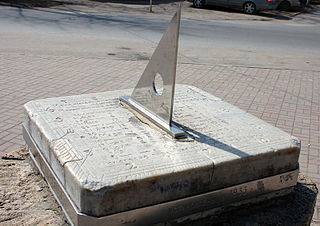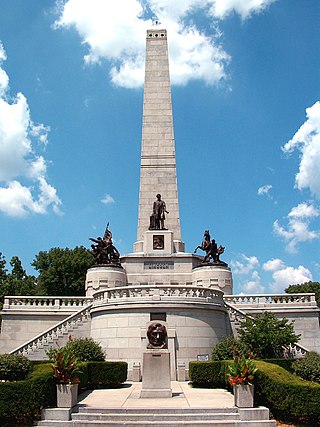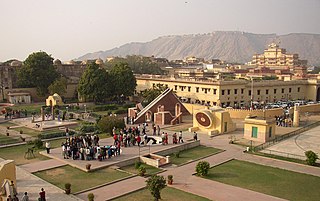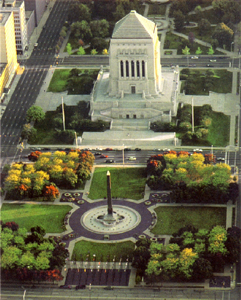
The Vietnam Veterans Memorial, commonly called the Vietnam Memorial, is a U.S. national memorial in Washington, D.C., honoring service members of the U.S. armed forces who served in the Vietnam War. The two-acre (8,100 m2) site is dominated by two black granite walls engraved with the names of those service members who died or remain missing as a result of their service in Vietnam and South East Asia during the war. The Wall, completed in 1982, has since been supplemented with the statue Three Soldiers in 1984 and the Vietnam Women's Memorial in 1993.

A sundial is a horological device that tells the time of day when direct sunlight shines by the apparent position of the Sun in the sky. In the narrowest sense of the word, it consists of a flat plate and a gnomon, which casts a shadow onto the dial. As the Sun appears to move through the sky, the shadow aligns with different hour-lines, which are marked on the dial to indicate the time of day. The style is the time-telling edge of the gnomon, though a single point or nodus may be used. The gnomon casts a broad shadow; the shadow of the style shows the time. The gnomon may be a rod, wire, or elaborately decorated metal casting. The style must be parallel to the axis of the Earth's rotation for the sundial to be accurate throughout the year. The style's angle from horizontal is equal to the sundial's geographical latitude.

A gnomon is the part of a sundial that casts a shadow. The term is used for a variety of purposes in mathematics and other fields.

The Sundial Bridge is a cantilever spar cable-stayed bridge for bicycles and pedestrians that spans the Sacramento River in Redding, California, United States and forms a large sundial. It was designed by Santiago Calatrava and completed in 2004 at a cost of US$23.5 million. The bridge has become iconic for Redding.

The Georgia Guidestones was a granite monument that stood in Elbert County, Georgia, United States, from 1980 to 2022. It was 19 feet 3 inches (5.87 m) tall and made from six granite slabs weighing a total of 237,746 pounds (107,840 kg). The structure was sometimes referred to as an "American Stonehenge". The monument's creators believed that there was going to be an upcoming social, nuclear, or economic calamity and they wanted the monument to serve as a guide for humanity in the world which would exist after it. Controversial from its time of construction, it ultimately became the subject of conspiracy theories which alleged that it was connected to Satanism.

The Lincoln Tomb is the final resting place of Abraham Lincoln, the 16th President of the United States; his wife Mary Todd Lincoln; and three of their four sons: Edward, William, and Thomas. It is located in Oak Ridge Cemetery in Springfield, Illinois.

The Jantar Mantar, Jaipur is a collection of 19 astronomical instruments built by the Rajput king Sawai Jai Singh, the founder of Jaipur, Rajasthan. The monument was completed in 1734. It features the world's largest stone sundial, and is a UNESCO World Heritage Site. It is near City Palace and Hawa Mahal. The instruments allow the observation of astronomical positions with the naked eye. The observatory is an example of the Ptolemaic positional astronomy which was shared by many civilizations.

The Polish Air Force Memorial is a war memorial in West London, England in memory of airmen from Poland who served in the Royal Air Force as part of the Polish contribution to World War II. Over 18,000 men and women served in the Polish squadrons of the RAF during the war, and over 2,000 died. The memorial marks the southern extremity of South Ruislip in the London Borough of Hillingdon, near RAF Northolt, where seven Polish-manned fighter squadrons were based at different times in the war.

The Wesley Bolin Memorial Plaza is an urban park and gathering place in front of the Arizona state capitol complex in downtown Phoenix, Arizona. One of the Phoenix Points of Pride, it is the site of various memorials honoring prominent figures, wars, and events in Arizona history.

Analemmatic sundials are a type of horizontal sundial that has a vertical gnomon and hour markers positioned in an elliptical pattern. The gnomon is not fixed and must change position daily to accurately indicate time of day. Hence there are no hour lines on the dial and the time of day is read only on the ellipse. As with most sundials, analemmatic sundials mark solar time rather than clock time.

The Indiana World War Memorial Plaza is an urban feature and war memorial located in downtown Indianapolis, Indiana, United States, originally built to honor the veterans of World War I. It was conceived in 1919 as a location for the national headquarters of the American Legion and a memorial to the state's and nation's veterans.

Man Enters the Cosmos is a cast bronze sculpture by Henry Moore located on the Lake Michigan lakefront outside the Adler Planetarium in the Museum Campus area of downtown Chicago, Illinois.

The Carefree Sundial, in Carefree, Arizona, was designed by architect Joe Wong and solar engineer John I. Yellott (1908-1986), was erected in the Sundial Circle plaza in 1959. The sundial is made from a steel frame and covered in anodized copper. As originally designed the 1200mm wide gnomon acted as a heat collecting plate for a local heating scheme. It measures 90 feet (27 m) in diameter. The metal gnomon, the shadow-casting portion of the dial, stands 35 feet (11 m) above the plaza and extends 62 feet (19 m). Local apparent time is 27.7 minutes behind the meridian time which here is Mountain Standard Time. The hour markers are adjusted accordingly.

Vietnam Veterans Plaza is an American memorial plaza in Manhattan, New York. It honors New York City citizens who served during the 20th-century Vietnam War.

The San Antonio Municipal Auditorium was a building located at 100 Auditorium Circle, San Antonio, Texas. It was built as a memorial to American soldiers killed in World War I.

The Kentucky War Memorial is a memorial to Kentuckians who have died in all wars. On a high-point called the "State Mound" in Frankfort Cemetery in Frankfort, Kentucky, the memorial consists of a 65-foot-tall monument erected in 1850, nine low stone monuments built in a semi-circle, and two low straight monuments. The 1850 monument honors men who died up until 1850 and it lists the battles and the officers who fell. The semi-circular area to the south of the tall monument lists the wars, and the straight monuments list the names of all of Kentucky's fallen. The wars mentioned include: War of Independence, War of 1812, the Texas War of Independence, the Mexican War, Civil War, Spanish–American War, World War I, World War II, Korean War, Vietnam War, and Persian Gulf War.

The Philadelphia Vietnam Veterans Memorial at Penn's Landing in Philadelphia, Pennsylvania was dedicated in 1987. The memorial includes the names of 648 servicemen who were killed in action or listed as missing in action during the Vietnam War from Philadelphia.
The Augusta-Central Savannah River Area (CSRA) Vietnam War Veterans Memorial is a granite and bronze monument placed in Augusta, Georgia, March 29, 2019, to honor the CSRA's 169 Vietnam War dead, three Ex-Prisoners of War (Vietnam), and one former Missing in Action (MIA) as well as the region's 15,000 surviving Vietnam War Veterans. The memorial is located in the "Olde Town" section of Augusta, Georgia, on the Broad Street median between Third and Fourth Streets. The monument was designed, purchased, and placed by the Augusta Chapter of the Military Order of the World Wars (MOWW) and the chapter's 17 community partners who made up the Augusta-CSRA Vietnam War Memorial Initiative (VWMI) Steering Committee.

"Dutchy" is the nickname of a Confederate monument in Elberton, Georgia. Unveiled in 1898, the statue was criticized for its poor design, and in 1900 the statue was toppled and buried by townspeople. The statue was later unearthed in 1982 and currently is on display in a local museum.

The Class of 1885 Memorial Sundial is a landmark at Columbia University, located at the center of the College Walk at the other end of Butler Plaza from Butler Library. Designed by astronomy professor Harold Jacoby in conjunction with McKim, Mead & White, it was completed in 1914. The 16-short-ton (15 t) granite sphere that once sat on top of it, at some point considered the largest stone sphere in the world, was removed in 1946 after it began to crack; efforts have been made toward its recovery since it was rediscovered in Michigan in 2001. The sundial's bare platform now serves as a popular meeting area for students, as well as a center for campus politics.






















